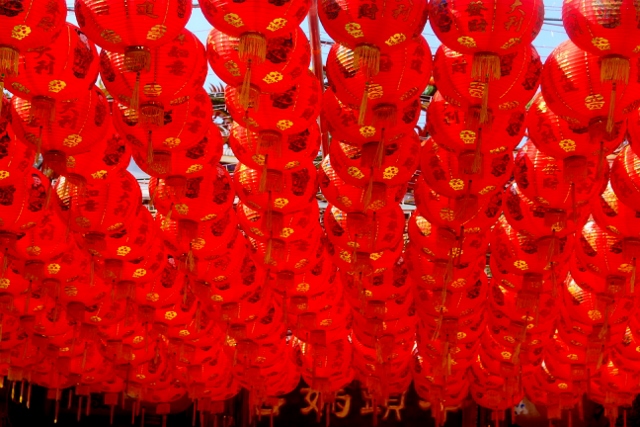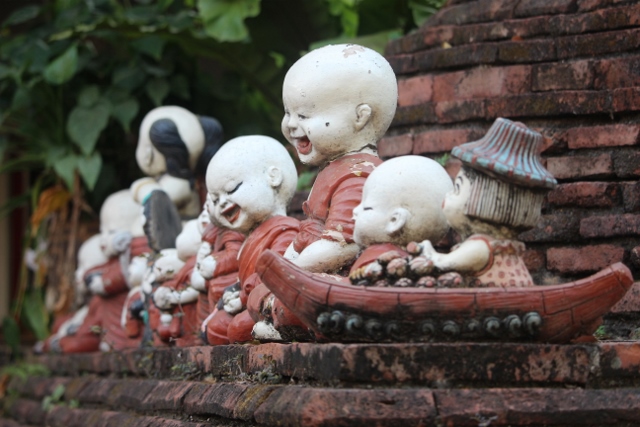Ayutthaya, the first of the old Thai capitals we visit, has many impressive ruined tempels, as well as lots of active ones, but the entourage lacks the atmosphere of other some ancient temple complexes.
Of course we cannot exit Thailand without having seen the old capital cities Ayutthaya and Sukhothai, north of Bangkok. Sukhothai, established somewhere halfway the 13th Century, is considered by many Thai to be the first capital of the kingdom that became known as Siam, the old name for Thailand – although modern history traces the Thai origins further back. It started as a fairly autonomous province of the Khmer empire, then broke away and dominated large swaths of territory in its own right, from parts of present day Myanmar to Luang Prabang in Laos. But soon afterwards, from middle 14th C onwards, the Sukhothai kingdom was overshadowed by the Ayutthaya kingdom, which invaded and put Sukhothai under its control. Thai historians like to speak of a merger rather than a takeover, but fact is that the city of Sukhothai greatly diminished in importance. Ayutthaya took over as capital, and being much better located, at the intersection of international trade between China, India and the Malay peninsula, it quickly grew to be – or so it is reputed – the largest city in the world at the time, with over 1 million inhabitants around 1700. Until it was invaded by the Burmese in 1767, who burned the city to the ground, which wasn’t so difficult with almost everything built from wood. What is left now are the few stone buildings, the temples and a few of the palaces, most of which are concentrated on an island, surrounded by three rivers, of which the Chao Praya, the one that continues to Bangkok, is the biggest, and busiest.
We arrive by train from Bangkok, which conveniently stops close to one of the rivers bordering the old town on the island. A little ferry brings us to the other side. The next day we rent some bicycles from our little guesthouse – yes, again! -, and explore the main temples, with the help of a map, on which many of the helpful people who all want to sell us their tours have scribbled what they think is important. So that the map has become virtually unreadable. Although the cycling to the various main temples amounts to some 20 km, we must have done a multiple of that – which, apparently, is not unusual; although the island is touted as an historical park, in fact each of the temple sites are on individual grounds, in between which major roads, industrial complexes, universities and residential areas have grown, all without much reliable sign posting.
Having said so, the sites are definitely worth the effort. There must be hundreds of temples around, of which many of the most important ones are ruined, but others are still active places of worship. With only one full day available – even our trips do come to an end, at some time -, and with temperatures soaring into the low 30s, we limit ourselves to a handful of the bigger complexes. In all honesty, there is also only so much one can admire in terms of temples, before the good old temple fatigue sets in.
I will illustrate the individual complexes more extensively at a later stage. For the time being, some pictures of the highlights, which frequently include a central temple tower, the so-called prang – which, if you don’t mind me saying, on quite a few occasions has the distinct shape of a phallus -, several secondary towers, stupas and spires distributed around the prang, and to one side the remains of a colonnaded royal enclosure. Many of the sites include Buddha sculptures, almost invariably decapitated; a sad sight, especially because many of the bodies have also cracked, or are badly eroded, beyond recognition. The claim is that the Burmese invading armies chopped all the heads off the Buddhas, but more likely looters did so afterwards, and sold the heads to collectors, who in those days were predominantly Western individuals and museums.
Wat Ratchaburana, the first on our list, is one of those temples with a tall central tower, mostly white. There are some decorations, although very little compared to the Khmer temples we visited earlier in Nachon Ratchasima. Wat Pra Sri Sanphet is distinct in that the complex comprises of several stupas, in the form of grey-white stuccoed steep conical spires, which in turn are surrounded by red-brick lower stupas. Wat Phra Ram is perhaps the least interesting of the main complexes, a distinctly phallus-like structure built from red brick at the lower and middle part, and a stuccoed top. The tower is surrounded by further red-brick stupas, lesser buildings and a compound wall. Wat Mahathat is the last of the big four on the island, with several impressive towers as well as lower structures – which may have been taller in the past, but have now collapsed. This is also where one of the Buddha heads have been preserved, in between the roots of a large tree.
Next to the ruined temples, there are also temples that are part-ruined, but also contain an active part, where worship continues, lots of local people bringing offerings. One of them in particular stands out, Wat Thammikarat, where on the platform of a collapsed structure a whole collection of cocks is being presented (no pun intended). The temple seems to generate income by selling those, and a whole lot of other paraphernalia. Which is fine, of course, but this, and even more so the endless tourist stalls at some of the large ruined complexes, as well as the elephant rides outside Wat Mahathat – there is something utterly ridiculous about a couple of foreigners sitting on top of an elephant and staring at their mobile phone screens -, all these blatant tourist businesses randomly distributed throughout the so-called Historical Park somewhat undermine the magic that such a place could evoke (and indeed does in places like Bagan and Angkor Wat).
The one thing not to be missed, despite the relatively high entrance fee, is the Chao Sam Phraya National Museum, also on the island. The museum displays an array of artefacts recovered from Ayutthaya temples, like a great variety of Buddha sculptures, but it is especially interesting for its large and unique collection of golden images and ornaments, many in the form of intricately decorated very thin golden leaves, which have been recovered from a couple of burial chambers (unfortunately, no photography permitted of those treasures).
Back in our guesthouse we have barely enough time to recuperate, before our next activity is due, a sunset boat trip around the Ayutthaya island, visiting even more temples, and for the rest taking in the life on and along the various rivers. Boat trips are always a pleasure, especially around sunset – although unfortunately, no cocktails were presented on board. The river is lined with wooden houses, many on stilts, many well-maintained. Multi-storey buildings are rare, the concept of river-view condos hasn’t rooted here yet. The river is mostly used by huge convoys of sand ships, pulled by often more than one tow boat, plus an extra one in the back to serve as the brake, I presume. All other traffic, including our small tour-boat, stays well away from these monsters, who go pretty fast and are perhaps not so agile.
The first of the temples of the tour is called Mae Nam Pa Sak, famous for its large golden Buddha, obviously fairly new, although perhaps equally interesting is the collection of old Buddha sculptures along the walls. The second one is Wat Phutthaisawan, a combination of an old temple with a new one, the tower of the old one, in the now familiar shape, meticulously copied. Between some of the ruined walls we encounter a large reclining Buddha, and along some of the other old walls new Buddha sculptures have been placed. The third and last temple, Wat Watthanaram, is one of the main historical sites, with a number of steep conical stupas surrounding the tower, and perhaps one of the most impressive sites we have seen in Ayutthaya, although this may be influenced by the fact that we are there close to sunset.
What we didn’t have time for, were the remains of the Dutch, Japanese and Portuguese settlements, the trading posts set up during Ayutthaya’s golden age. Of which, according to one source, there is preciously little left to see. Better then, to move to that other ancient Thai capital, Sukhothai.












































